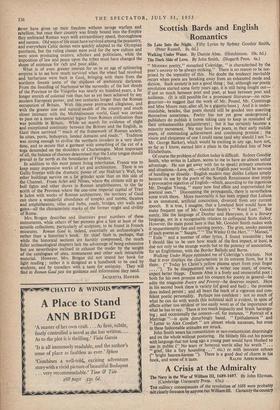All Gaul
Roman Gaul. By Olwen Brogan. (Bell. 21s.) ThE first Roman colony outside Italy was established at Narbonne in 118 B.C. and by the beginning of our era the ruthless military conquest of the Province was a thing of the past, even if it still had its mementoes in the men who were carrying into old age the scarred stumps of right arms from which the hands had been severed after the famous rising under Vercingetorix. The Celts, perhaps the most gifted of all the barbarian neighbours of the classical world, would
never have given up their freedom without savage warfare and rebellion, but once their country was firmly bound into the -Empire they embraced Roman ways with extraordinary speed, thoroughness and success. Old ways of life must have survived among the peasantry, and everywhere Celtic deities were quickly adapted to the Olympian pantheon, but the ruling classes were avid for the new culture and were soon producing orators, scholars and politicians, while the imposition of law and peace upon the tribes must have changed the shape of existence for rich and poor alike.
What is of even greater interest for us in an age of splintering empires is to see how much survived when the wheel had revolved and barbarians were back in Gaul, bringing with them from the northern forests some of the shadows of prehistoric darkness. From the founding of Narbonne to the surrender of the last shreds of the Province to the Visigoths was nearly six hundred years, a far longer stretch of colonial rule than has as yet been achieved by any modern European power, and two centuries longer than the Roman occupation of Britain. With this more protracted allegiance, and with the greater size and natural wealth of the country and much closer intimacy with the Mediterranean world, Gaul was certain to pass on a more substantial legacy from Roman civilization than was possible in Britain. While we search for evidence of slight and exceptional continuity between the Britons and the English, in Gaul there survived " much of the framework of Roman society, its cities, ports, bishoprics, landed domains and roads." Tradition was strong enough to civilise the northern invaders in a very short time, and to secure that a garment with something of the cut of a toga descended on the shoulders of Charlemagne. Most important of all, the balance of chances determined that the Latin tongue should prevail as far north as the boundaries of Flanders.
In addition to this most potent living inheritance, France was to keep many impressive works of art and architecture. There is no Gallic frontier with the dramatic power of our Hadrian's Wall, but other buildings survive on a far grander scale than on this side of the Channel. From Arles and Nimes, where The citizens still go to bull fights and other shows in Roman amphitheatres, to the far north of the Province where the one-time imperial capital of Trier is laden with works of Roman architecture, the territory of Gaul can show a wonderful abundance of temples and tombs, theatres and amphitheatres, villas and baths, roads, bridges, city walls and gates—all the characteristic marks of the former might and civility of Rome.
Mrs. Brogan describes and illustrates great numbers of these monuments, while others of her pictures give a hint at least of the notable collections, particularly of sculpture, to be found in French museums. Roman Gaul is, indeed, essentially an archaeologist's rather than a historian's book. Its chief fault is, perhaps, that while the historical sections are harshly compressed, the much fuller archaeological chapters lack the advantage of being exhaustive but are nevertheless inclined to exhaust the reader by the weight of the catalogues of sites, monuments and other such intractable material. However, Mrs. Brogan did not intend her book for light reading ; rather it is designed as a handbook to be used by students, and by travellers with a taste for antiquity. They will find in Roman Gaul just the guidance and information they need.
JACQUETTA HAWKES.



































 Previous page
Previous page